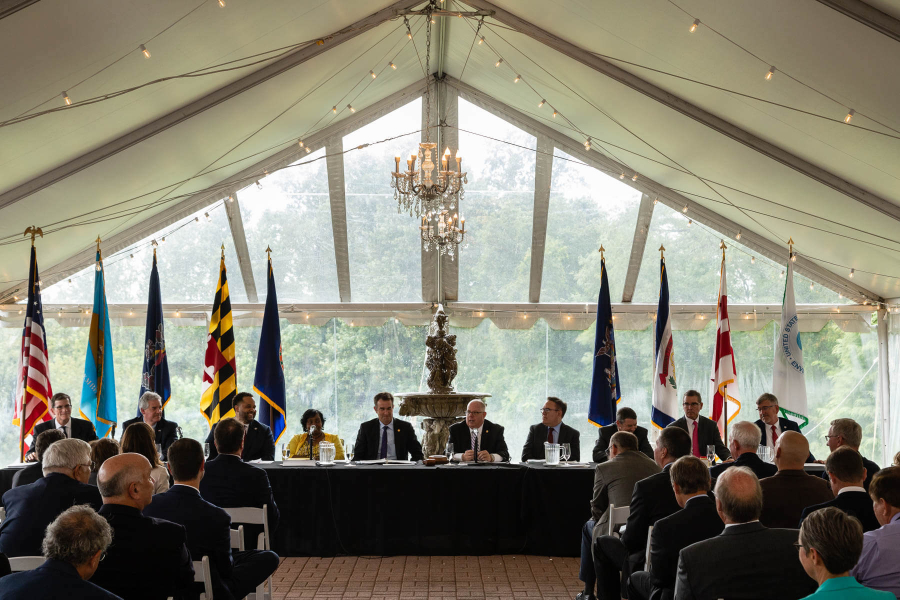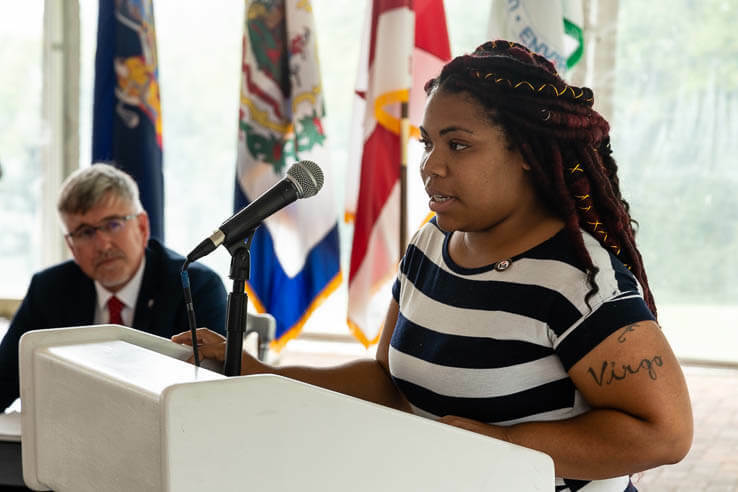Chesapeake Executive Council looks to the future
Annual meeting focuses on challenges, successes in meeting pollutant reduction goals

Perched high above the Potomac River, the historical Oxon Hill Manor played host today to leaders from around the Chesapeake Bay watershed. Gathered together for the annual Chesapeake Executive Council meeting, representatives from the six Chesapeake Bay watershed states, the District of Columbia, Chesapeake Bay Commission and the U.S. Environmental Protection Agency (EPA) discussed the current state of watershed restoration and the challenges that remain in reducing pollution flowing into the Bay.
The theme of this year’s meeting, Rising to the Challenge: Ensuring a Sustainable Future for our Watershed, is a nod to the recently submitted Phase III Watershed Implementation Plans. Each of the Chesapeake Bay watershed jurisdictions (Delaware, Maryland, New York, Pennsylvania, Virginia, West Virginia and the District of Columbia) prepared detailed strategies that outline how they plan to meet their pollutant reduction goals under the Chesapeake Bay Total Maximum Daily Load (Bay TMDL). The plans are currently under review by the EPA.
Each member of the Executive Council spoke during the meeting about some of the innovative ways they plan to reduce pollutants by 2025.
“In just the last year, Virginia has made significant progress in meeting our conservation and restoration goals,” said Virginia Governor Ralph Northam. “Working with scientists, policy experts and a wide range of stakeholders, we have designed a bold and comprehensive roadmap that not only enables Virginia to fulfill its commitment to restoring the health of the Chesapeake Bay by 2025, but also fully addresses the increased pollution caused by development and climate change.”
While members spoke of how they plan to meet their pollutant reduction goals, Skip Stiles, executive director of Wetlands Watch, used his remarks to remind attendees that certain conservation practices, like forest buffers and wetlands, not only help improve water quality, but are also beneficial to addressing climate change, as well as achieving the goals and outcomes of the Chesapeake Bay Watershed Agreement. Increasing forest buffers and wetlands are two areas in which the multi-state partnership continues to struggle.

Queen Richardson, with the Alliance for the Chesapeake Bay, used her time before the council to elaborate on how D.C. plans to meet their pollutant reduction goals—by investing in their residents. Richardson participated in several D.C. green job training programs, which led her to her current position at the Alliance as a RiverSmart Homes Program Assistant.
“When we restore our streams, wetlands and shorelines, and reduce polluted runoff, we create economic opportunities for our residents and businesses and make our city more resilient to the impacts of climate change,” said Washington D.C. Mayor Muriel Bowser. “The District’s clean up strategy is about investing in our infrastructure and in our people and making sure we’re doing our part to clean up the Chesapeake Bay.”
In a lunch before the meeting, members of the Executive Council heard reports from representatives of citizens, local governments and scientists from around the watershed.
Dr. Brian Benham, chair of the Chesapeake Bay Program’s Scientific and Technical Advisory Committee (STAC) reminded members that “sound science is key to cost-effective restoration management… and with accelerating climate change and other emerging environmental issues affecting water quality and living resources, STAC encourages the partnership to maintain its commitment to developing and implementing effective evidence-based management to sustain Bay restoration progress.”
Maryland Governor Larry Hogan was also elected chair of the Executive Council for a third consecutive term.
“I am incredibly honored to have been reelected to serve as chair of this Executive Council for the year ahead, and I believe very strongly that if we continue to embrace a spirit of bipartisan cooperation, we can, and we will, find real, commonsense solutions to protect the Chesapeake Bay,” said Hogan.
Established over 35 years ago, the Executive Council is responsible for guiding the policy agenda and setting conservation and restoration goals for the regional, watershed-wide Chesapeake Bay Program partnership.

Comments
There are no comments.
Thank you!
Your comment has been received. Before it can be published, the comment will be reviewed by our team to ensure it adheres with our rules of engagement.
Back to recent stories